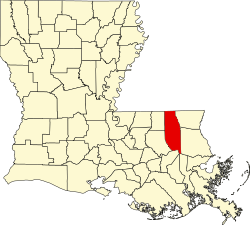Natalbany, Louisiana | |
|---|---|
| Coordinates: 30°32′55″N90°29′42″W / 30.54861°N 90.49500°W [1] | |
| Country | United States |
| State | Louisiana |
| Parish | Tangipahoa |
| Area | |
• Total | 4.47 sq mi (11.58 km2) |
| • Land | 4.43 sq mi (11.46 km2) |
| • Water | 0.04 sq mi (0.11 km2) |
| Elevation | 56 ft (17 m) |
| Population (2020) | |
• Total | 2,510 |
| • Density | 567.10/sq mi (218.97/km2) |
| Time zone | UTC-6 (CST) |
| • Summer (DST) | UTC-5 (CDT) |
| Area code | 985 |
| FIPS code | 22-53475 |
| GNIS feature ID | 2403328 [1] |
Natalbany is a census-designated place (CDP) in Tangipahoa Parish, Louisiana, United States. The population was 1,739 at the 2000 census. It is part of the Hammond MSA.
Contents


